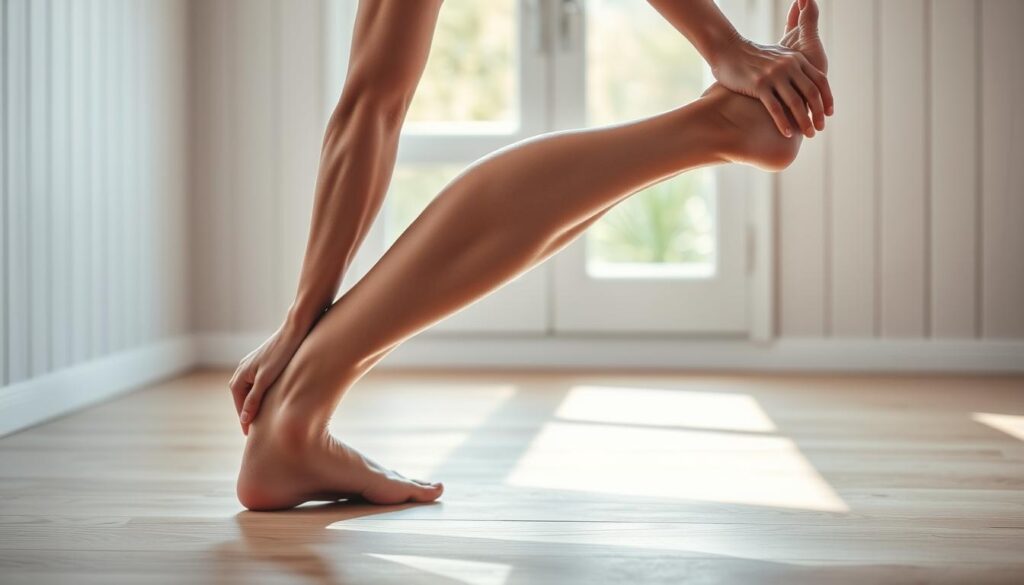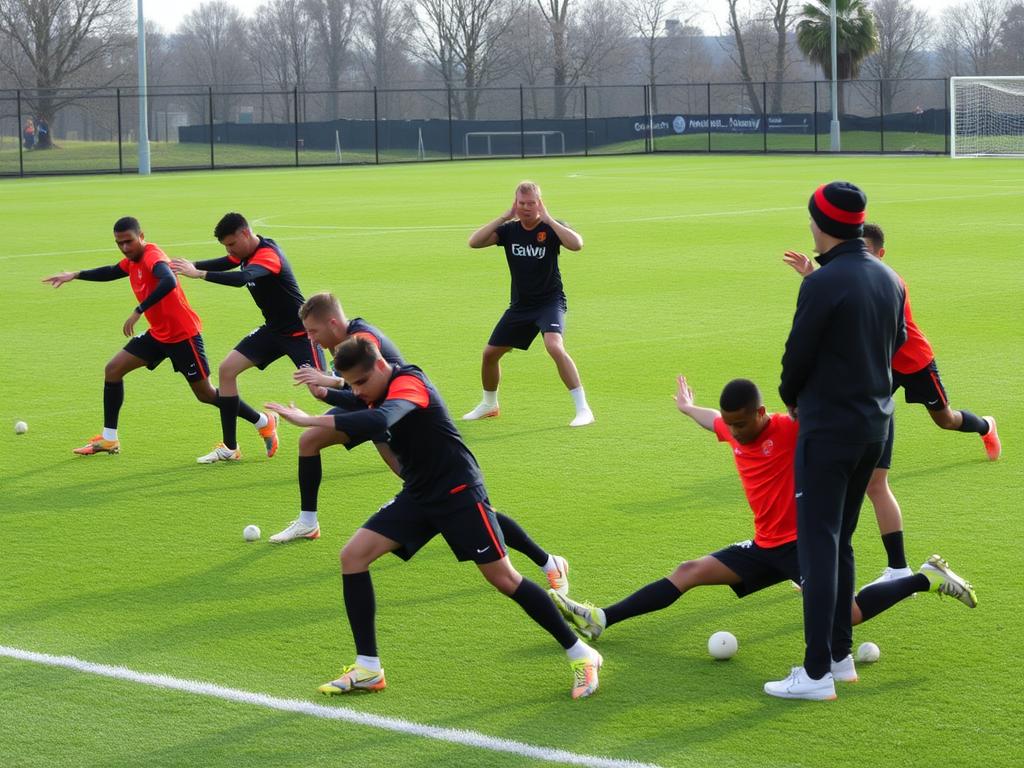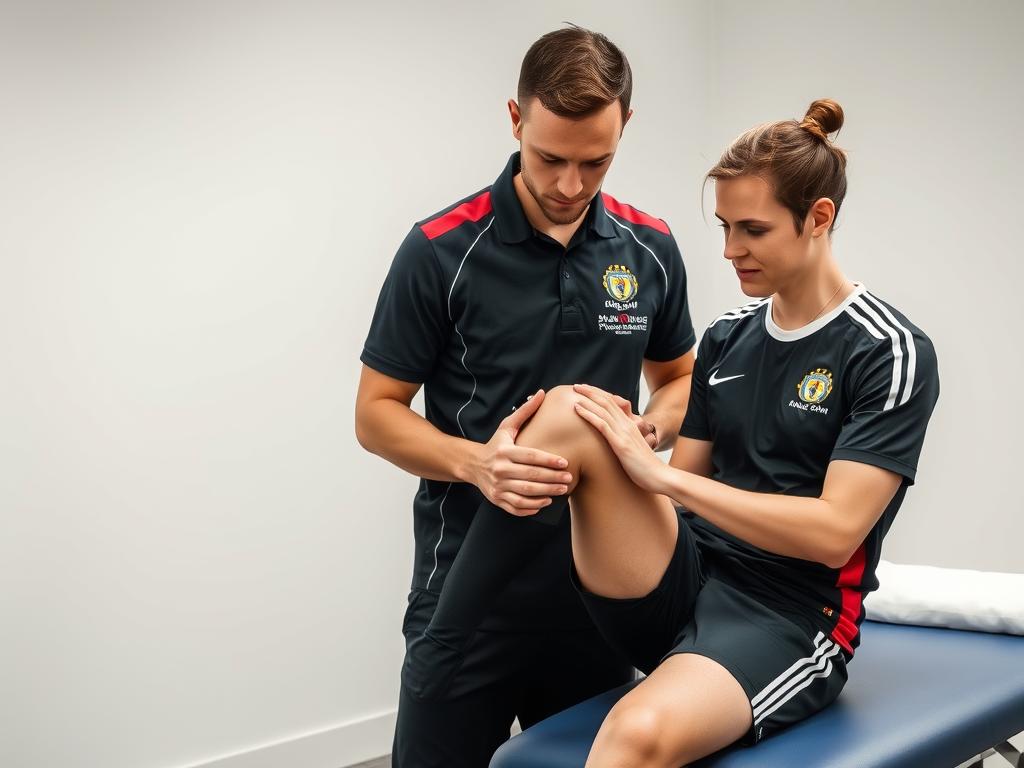Climbing a ladder can be tough, especially if you’re not ready. Have you thought about how it affects your knees, especially the meniscus?
Not stretching can lead to injuries, like meniscus tears. Knowing the value of stretches before using a ladder is key to safer climbing.
Key Takeaways
- Understand the risks associated with ladder climbing.
- Learn simple stretches to prevent meniscus tears.
- Discover how to prepare your body for safe ladder climbing.
- Reduce the risk of injury with proper stretching routines.
- Improve your overall safety while working at heights.
Importance of Stretching Prior to Ladder Use

Before climbing a ladder, it’s key to stretch our bodies. Stretching is more than a routine; it’s a safety step that lowers accident and injury risks. It boosts flexibility, improves blood flow, and gets muscles ready for climbing.
Benefits of Stretching
Stretching has many benefits, especially for those who often use ladders. It helps prevent muscle strain. This can lower the chance of meniscus tears, which cause pain, swelling, and limited movement. Meniscus tear symptoms need treatment, from physical therapy to surgery.
Stretching also makes it easier to climb ladders safely. It boosts balance and coordination, cutting down fall risks.
Prevention of Injuries
Stretching before ladder use is a big injury prevention. It gets muscles and joints ready, lowering the risk of sudden injuries and long-term problems. This includes strains, tears, and chronic conditions from repetitive strain or poor flexibility.
“The best way to prevent injuries is to prepare your body for the task at hand. Stretching is a simple yet effective way to reduce the risk of accidents when using ladders.”
Improving Flexibility
Flexibility is key for safe ladder climbing. Being flexible helps us control our movements better, lowering the risk of losing balance or straining muscles. Stretching exercises for muscles like hamstrings, quadriceps, and hip flexors are especially helpful.
| Muscle Group | Stretching Exercise | Benefit |
|---|---|---|
| Hamstrings | Standing Forward Bend | Improves flexibility in the back of the legs |
| Quadriceps | Quad Stretch | Enhances flexibility in the front of the legs |
| Shoulders and Arms | Shoulder Rolls and Arm Circles | Reduces strain and improves mobility |
Adding these stretches to our pre-ladder routine boosts safety and cuts injury risks, including meniscus tears.
Key Muscle Groups to Target

Stretching is more than just a routine. It’s about focusing on the right muscles to avoid injuries when using a ladder. When we climb, several muscle groups are engaged. Preparing them is key for a safe climb.
Our main focus should be on the major muscle groups involved in ladder climbing. These include the hamstrings and quadriceps in the legs, the muscles in our shoulders and arms, and the core muscles that provide stability.
Hamstrings and Quads
The hamstrings and quadriceps are crucial for climbing. The hamstrings help bend the knee, while the quadriceps are key for straightening it. Stretching these muscles can prevent strains and tears, like meniscus tears, which can be painful and may need surgery.
To stretch the hamstrings, stand with feet shoulder-width apart and bend forward at the hips. For the quadriceps, a standing quadriceps stretch, bending the leg backward, is effective.
Shoulders and Arms
The shoulders and arms are vital in ladder climbing, especially when carrying tools or equipment. Stretching these areas can prevent strain and improve climbing ability.
A simple shoulder stretch involves holding one arm straight out to the side and pulling it toward the shoulder blade with the other arm. For the arms, a triceps stretch, holding the arm straight out behind and pulling on the elbow, is beneficial.
Core Muscles
The core muscles, including the abdominals and lower back, are essential for balance on a ladder. Stretching these muscles can enhance stability and reduce the risk of falls.
A simple core stretch involves standing with feet shoulder-width apart and twisting from side to side. This improves flexibility and balance.
By focusing on these key muscle groups, we can greatly reduce injury risk while using a ladder. This ensures a safer climbing experience.
Recommended Stretches for Ladder Use

Before climbing a ladder, it’s key to stretch the right muscles. Doing specific exercises can make us more flexible and lower injury risk. These stretches help us move better and get ready for the ladder’s physical challenges.
Standing Forward Bend
The standing forward bend is a great stretch for the hamstrings and calves. These muscles are vital for staying balanced on a ladder. Stretching them improves our flexibility and stability, just like in meniscus tear recovery exercises.
Shoulder Stretch
Good shoulder mobility is essential for balance on a ladder. The shoulder stretch involves holding one arm straight and then pulling it across the body. This stretch helps those in meniscus tear physical therapy by making the upper body more flexible.
Side Stretch
The side stretch targets muscles on our sides, helping us stay balanced on the ladder. Stretching these muscles boosts our stability and lowers the chance of falls.
| Stretch | Target Area | Benefit |
|---|---|---|
| Standing Forward Bend | Hamstrings, Calves | Improved flexibility and balance |
| Shoulder Stretch | Shoulders | Enhanced upper body mobility |
| Side Stretch | Side muscles | Better stability and balance |
Timing Your Stretches
Getting the timing right for stretches is key to better flexibility and injury prevention when using a ladder. Stretching at the right time helps us climb safely and efficiently.
Pre-Climb Stretching Routine
Having a pre-climb stretching routine is crucial. It prepares our muscles for what’s coming. This routine should cover key muscle groups like hamstrings, quadriceps, shoulders, and core.
For example, a standing forward bend stretches our hamstrings and back well. A shoulder stretch prevents shoulder and arm strain.
Duration of Each Stretch
How long we hold a stretch matters a lot. Holding for 15-30 seconds is best. It relaxes the muscle and boosts flexibility.
It’s also key to listen to our body. Adjust the stretch time if needed. If we feel pain, stop right away.
Listening to Our Body
Knowing our body’s signals is vital to avoid injury. Injuries like meniscus tears or ACL tears can happen. Spotting these injuries early is crucial for the right treatment.
| Stretch | Duration | Benefit |
|---|---|---|
| Standing Forward Bend | 15-30 seconds | Stretches hamstrings and back |
| Shoulder Stretch | 15-30 seconds | Relaxes shoulders and arms |
| Side Stretch | 15-30 seconds | Improves flexibility in the sides |
By listening to our body and knowing injury risks, we can prevent them. This means being careful with our stretching and not overdoing it.
Safety Tips While Using a Ladder
Using a ladder safely is more than stretching. It’s about paying attention to important details. We need to think about more than just getting ready physically.
Before climbing, make sure the ladder is set up right. This means picking a solid, flat spot and ensuring the ladder doesn’t move.
Proper Ladder Positioning
To set up a ladder correctly, follow these steps:
- Place the ladder on a firm, level surface.
- Make sure the ladder feet are secure and won’t slip.
- For extension ladders, use the 4-to-1 rule: for every 4 feet up, move the base 1 foot away from the wall.
Maintaining Balance
Keeping your balance on a ladder is key. Here’s how to do it:
- Always have three points of contact (two hands and one foot, or two feet and one hand).
- Avoid reaching too far, which can make you lose balance.
- Stay centered between the side rails.
Wearing Appropriate Footwear
The right shoes are crucial for ladder safety. Choose shoes that are:
- Sturdy and have good grip to prevent slipping.
- Not muddy, oily, or slippery, which can cause falls on the ladder.
Let’s look at safe vs. unsafe ladder practices in a table:
| Safety Aspect | Safe Practice | Unsafe Practice |
|---|---|---|
| Ladder Positioning | 4-to-1 rule for extension ladders | Leaning against unstable surfaces |
| Balance | Three points of contact | Overreaching or standing on the top rung |
| Footwear | Sturdy shoes with good grip | Sandals or shoes with slippery soles |
Conclusion: Making Stretching a Habit
As we wrap up our talk on stretches before using a ladder, it’s key to see how important stretching is. It boosts flexibility, lowers injury risk, and improves our overall health.
Benefits of Regular Stretching
Stretching regularly brings many benefits. It improves how well we move and reduces muscle tightness. This makes everyday tasks easier and more confident.
Encouraging a Culture of Safety
We can make our surroundings safer by getting others to stretch too. This shared effort creates a safer, healthier space at work and at home.
Long-term Benefits for Safety and Mobility
Stretching is more than just ladder safety. It also boosts our flexibility and mobility. These improvements make life better, making stretching a habit worth keeping.
FAQ
What are the common symptoms of a meniscus tear?
Symptoms of a meniscus tear include knee pain and swelling. We might also feel stiffness and have trouble moving our knee. Sometimes, we hear a popping sound when the tear happens.
How can stretching before using a ladder help prevent meniscus tears?
Stretching before climbing a ladder can prevent meniscus tears. It makes our muscles more flexible. This helps us stay balanced and avoid accidents that could hurt our knees.
What are the treatment options available for a meniscus tear?
Treatments for a meniscus tear vary. They can include physical therapy and pain management. Sometimes, surgery is needed. The right treatment depends on the tear’s severity and our health.
How can we differentiate between a meniscus tear and an ACL tear?
Telling apart a meniscus tear from an ACL tear can be hard. Both can cause knee pain and instability. ACL tears often happen suddenly and with a loud sound. Meniscus tears can come from twisting or wear and tear. A doctor’s diagnosis is key to figuring out the injury.
What is the typical recovery process for a meniscus tear?
Recovering from a meniscus tear involves rest, physical therapy, and sometimes surgery. Exercises help improve knee function. Physical therapy is crucial for getting back to normal activities.
How can we prevent meniscus tears when using ladders?
To avoid meniscus tears with ladders, follow safety rules. Keep three points of contact on the ladder and wear the right shoes. Also, stretch before climbing to improve balance and flexibility.
What are the long-term benefits of incorporating stretching into our routine?
Stretching regularly offers many benefits. It improves flexibility and reduces injury risk. It also helps with posture, muscle tension, and overall health. Stretching is a great way to stay healthy and safe.










